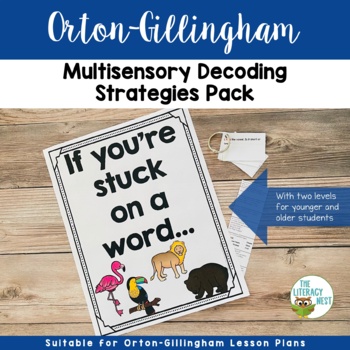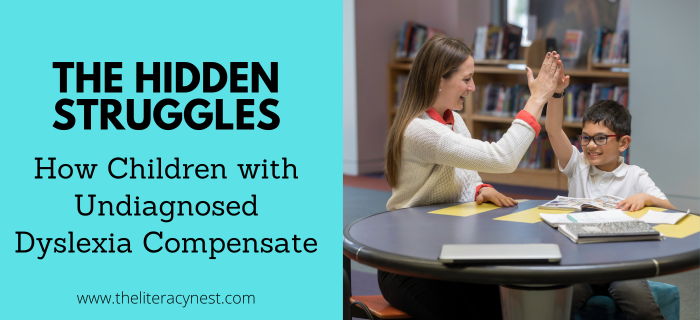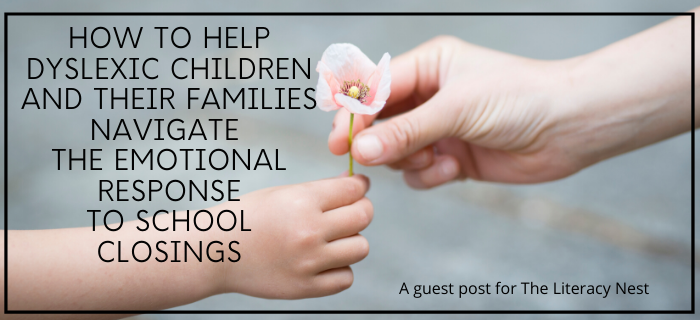What to Do (and NOT Do) if Your Child is Struggling with Reading and You Suspect Dyslexia

Does your child struggle with reading? It could be dyslexia.
- Perhaps your child is struggling with reading and writing and you are questioning what might be going on.
- Maybe you’ve seen a list of red flags for dyslexia and see some of them in your son.
- Reading may have been hard for you and now you are seeing similar challenges in your daughter.
If this sounds like you, you may be suspecting dyslexia. Dyslexia is the most common reading disability and occurs along a spectrum of severity. But if you have that suspicion, what should you do next?
This blog post will give you tips on what to do and what not to do when your child is having reading difficulties.
Nine things to do when your child is struggling with reading…
1. Discuss your concerns with your child’s classroom teacher(s).
Your child’s teacher has the advantage of seeing a diverse group of learners at your child’s grade level and may be able to share helpful information. However, most classroom teachers are not specifically trained in warning signs of dyslexia, the frequency with which dyslexia occurs, and just because they don’t see a problem, doesn’t mean you are off base.
2. Request testing.
Many parents don’t realize that you do not need the teacher to begin testing. As the parent, you can make a written request to the school to do special education testing when suspect your child is struggling with reading. It is worthwhile to mention your suspicions and ask that the person doing the testing specifically look for indicators of dyslexia.
3. Take action immediately.
Parents are often encouraged to give a child time or wait for them to “catch up”, but early intervention is part of helping students manage dyslexia well. Special education testing is often a very time-consuming process, so getting the ball rolling sooner with struggling readers, rather than later, is wise.
4. Educate yourself.
It pays to be knowledgeable not only about dyslexia and other learning challenges but the IEP process and law.
Here are 6 Tips for Parents Navigating the IEP Process.
A parent that knows their rights and the rights of their child is able to be a strong advocate. Ask questions and make sure you understand any decisions that are being made. Be sure what you agree to in conversation matches what is written in an IEP for your child’s learning disability.
You can visit WrightsLaw for accurate, up-to-date information about special education law and advocacy for children with disabilities.
5. Trust your instincts.
You are the parent and know your child better than anyone. Learning challenges aren’t always lit up like a neon sign. Sometimes, the emotional and behavioral things that you are seeing at home are very telling.
I know a literacy specialist that first raised concerns about her daughter’s reading in 3rd grade. Her previous love of books wasn’t carrying over to chapter books and her happy cooperative child didn’t want to read.
Year after year, she kept raising questions, repeatedly being reassured that her daughter just needed to spend more time reading, even as she slipped from exceeding standards to meeting to just barely reaching her goals.
Finally, seeing her teenage daughter wracked with anxiety, in desperation this woman followed her instincts and got an outside evaluation. Her daughter was finally diagnosed at age 16 with more than one learning disorder: dyslexia, dysgraphia, and ADHD. A weight was lifted off of both their shoulders and harmony was restored to their home.
6. Advocate for your child or find someone to assist you.
The squeaky wheel gets the grease. It is helpful to understand that you and the school may have different goals and different criteria for what success looks like for your child.
Listen to this episode of the Together in Literacy podcast to learn more about dyslexia advocacy: Season 1, Episode 16: The Legal Aspect of Dyslexia Advocacy with Sabrina Axt
7. Find a local or state chapter of Decoding Dyslexia.
The support and information from other parents that have been through similar things are invaluable. Find your local chapter of Decoding Dyslexia, right here.
8. Consider a tutor who specializes in dyslexia intervention.
It is important to work with someone that has been specially trained in working with learners with dyslexia and how best to meet their needs. Tutoring is a great way to provide your child with individualized intensive instruction that a public school simply can’t provide.
Search a database of specially trained tutors across the US and Canada: Orton-Gillingham Tutor Directory
9. Create a paper trail and organize all testing reports.
The amount of paper can be overwhelming. Don’t wait for it to pile up. Creating a dedicated notebook from the start can be very helpful. Mistakes happen, and deadlines get missed, but being organized yourself is one of the best ways to be an effective advocate for your child.
If your child is struggling with reading, he or she may benefit from multisensory decoding strategies. Check this out for more information…
And, seven things NOT to do when your child is struggling with reading…
1. Don’t wait if you suspect a problem.
Trust yourself and act on your instinct. Time is precious. I don’t know what the statistics are, but in most families I tutor, the parent suspected a problem in their child’s ability to read before the school did. Early identification of struggling students can help dyslexic children learn to read quicker, which will help them long term.
2. Don’t hire a tutor that doesn’t have specialized training in dyslexia intervention.
Students with dyslexia need specialized instruction, hiring someone that is certified in an Orton-Gillingham-based program or method is important to ensure that your child is getting the type of instruction necessary for success in their academic development.
Read this post for more tips to find a tutor with specialized training for dyslexia intervention: 4 Tips to Find an Orton-Gillingham Tutor
3. Don’t rely on school-based reading that isn’t helping your child make steady uphill progress.
Most classroom curriculums are not designed for the learner with dyslexia, rather they suit the needs of an entire class and forget about students who need additional support. Just using the regular classroom program is not going to help your child overcome their challenges when they are struggling with reading. Many intervention programs are also not designed for a student with dyslexia. Multisensory, sequential, structured language instruction is the proven remediation for dyslexia.
4. Don’t give up.
It can take a long time and a lot of persistence to get a diagnosis and appropriate intervention. Your diligence is very important.
5. Don’t stop reading aloud.
Many parents stop reading aloud to their children as soon as the child starts to read independently, even if the child’s interests and reading abilities don’t quite sync up. Please continue to read to your child or listen to audiobooks long after they’ve begun reading in school. My students that listen to age-appropriate books tend to have a better vocabulary, better comprehension, and utilize a variety of sentence structures in their written work.
Check out these Tools for Reading with Dyslexia at Home!
6. Don’t forget to have fun.
Reading and writing are hard work for kids with dyslexia. But, it is also really important work. The best thing you can do is make time for reading and writing work, but also be sure to encourage your child to participate in an activity that they excel in and that highlights their different strengths, whether it be sports, music, art, or karate.
7. Don’t fall for miracle cures and quick-fix promises.
Dyslexia is a lifelong neurological difference. While your child can learn to read and function as well as his or her peers, there is no such thing as a miracle program that cures dyslexia in 6 weeks. There are unfortunately lots of false promises out there that prey on desperation and our desire for our children to do well and find an easy way to fix it.
The good news is, with these tips, you’ll be navigating the challenges of effective advocacy in no time. Remember, follow your heart and trust your gut. Your child is counting on you.
October is Dyslexia Awareness month. Grab a FREE dyslexia awareness month interactive calendar for the month of October. It features links to blog posts, articles, videos, podcasts, PDF handouts, simulations, and much more.









HI Emily! Is there any way you can save the calendar on google drive? I am having a hard time since I do not use dropbox!
Thanks so much!
Thank you much! Informative, timely info that I'll be sharing with my families!
Hi there! Email me at theliteracynest.com and I will send you a Google Drive link. Thanks!
Thank you so much!
I am having a very difficult time saving the calendar. Can you send me a link for Google Drive also? Thanks
Same for me please! patricia.mcintire@msad60.org
Hi Emily, could you send me a link for the calendar please! Its fabulous!
Hi! I had to update that one on Dropbox. I changed it to Google Drive. Try this one instead: https://drive.google.com/file/d/155vVdIyFg7bZ3SJe65SbZgzJpdKrj1-4/view?usp=sharing